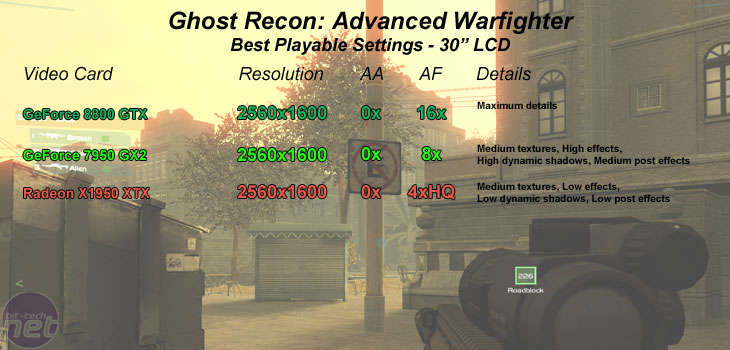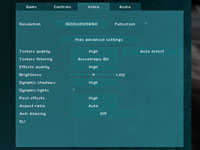
Ghost Recon Advanced Warfighter:
Publisher: UbisoftWe used the latest addition to Tom Clancy's Ghost Recon series - Ghost Recon Advanced Warfighter and patched the game to version 1.10. This has to be one of the best-looking games on the market at the moment, even despite its lack of support for anti-aliasing on any of today's current hardware. The game makes use of High Dynamic Range lighting and a whole plethora of special effects. Probably the biggest talking point for Ghost Recon Advanced Warfighter is its support for AGEIA's PhysX PPU.
The lack of support for anti-aliasing may seem like a backwards step in image quality, as there are many areas of the game that could certainly benefit from a multisample anti-aliasing pattern. The lack of anti-aliasing support is due to the fact that the game uses multiple render targets to achieve some of the advanced graphical effects. This is due to the way that the DirectX 9.0 specification was set out, and even if multiple render targets and anti-aliasing could work in harmony, it'd be incredibly costly because every surface in the multiple render target would need to be sampled.
We did a five minute manual run through from the start of the Strong Point level. This incorporates lots of post processing effects, HDR lighting, explosions, gun fire and water, too in order to give the graphics subsystem a good work out. The game has no support for anti-aliasing, but anisotropic filtering was controlled from inside the game.
________________________________________________________________________________
24" widescreen gaming:


The GeForce 8800 GTX was the best performer at this resolution and we were able to increase the anisotropic filtering quality to 16x. Overall, all three video cards look fantastic thanks to the next-generation effects that the Ghost Recon Advanced Warfighter engine is able to churn out. NVIDIA's GeForce 8800 GTX also had an advantage in terms of frame rate, but because the game is slow-paced, the increased average frame rate doesn't make all that much difference in this particular title.
________________________________________________________________________________
30" widescreen gaming:


We had to lower the in-game quality settings on both the GeForce 7950 GX2 and Radeon X1950 XTX. The Radeon X1950 XTX suffered the most, with details reduced to close-to-minimum in order to attain an acceptable gaming experience. Once again, the GeForce 8800 GTX simply ass-masters the 2560x1600 arena.

MSI MPG Velox 100R Chassis Review
October 14 2021 | 15:04









Want to comment? Please log in.